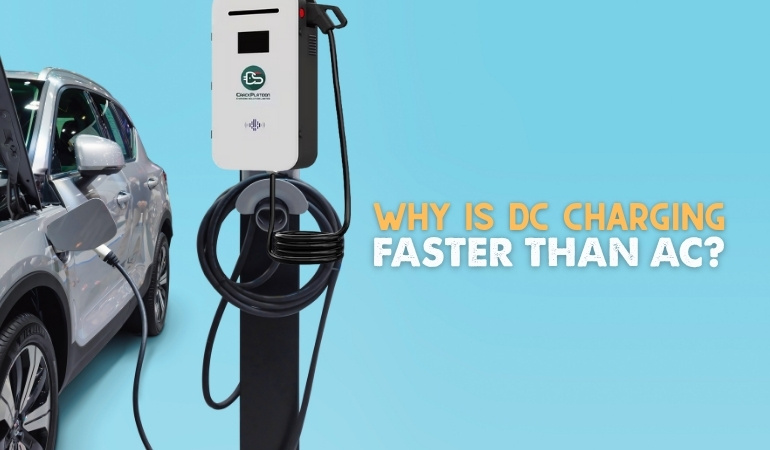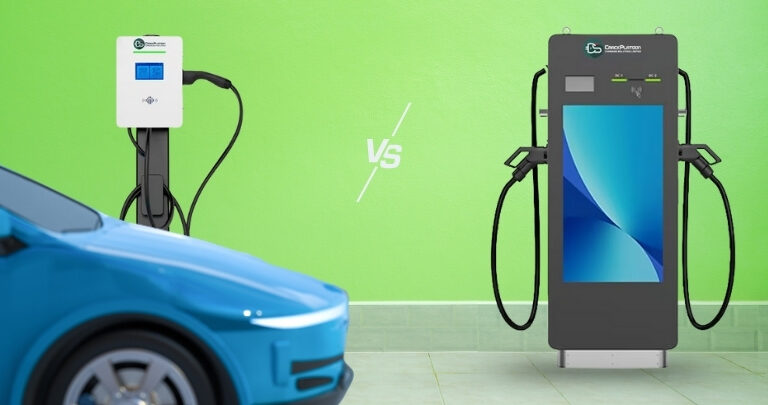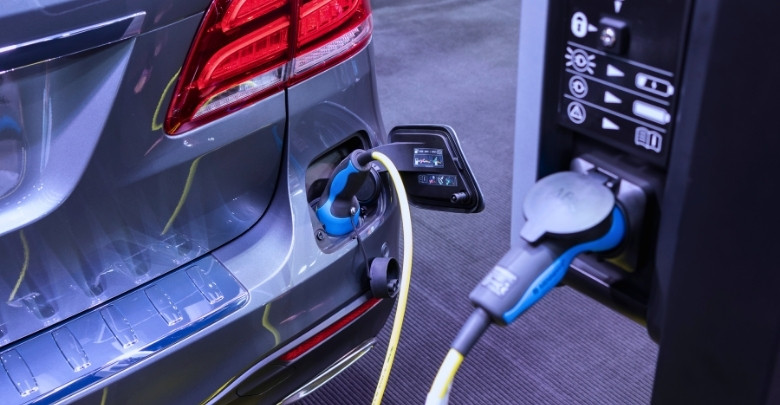Plugging into an EV charger is something many electric car owners do every day, whether they’re topping up at home or using a station in town. As more people switch to electric vehicles, the speed of charging becomes a big deal. That’s when a common thought pops up—Why is DC charging faster than AC?
DC charging is faster than AC charging because it sends power directly to the car’s battery without needing to convert it. AC power must be changed to DC inside the car using the onboard charger, which slows things down. DC chargers skip this step and deliver more power at once. This direct flow and higher power output make DC charging much quicker than AC.
Do you want to know more about how this works or what really makes the difference? If yes, keep reading—this article covers everything you need to know about the topic.
Why Is DC Charging Faster Than AC?
You might have noticed that DC charging stations fill up an electric car’s battery much faster than AC ones. But why is that? It all comes down to how power is sent and used. The difference between the two may seem small, but it really affects the charging speed in a big way. Here’s what makes DC charging faster.

Power Type Matters
There are two main types of electricity: AC (Alternating Current) and DC (Direct Current). The electricity that comes from your home or a wall outlet is AC. But car batteries only work with DC. When you charge with AC, it has to be changed into DC before going into the battery. That change takes time, and it makes the charging slower.
How Charging Works
AC charging sends power to the car, and then a device inside the car called the onboard charger changes that power into DC. This extra step takes time and slows down the whole charging process. With DC charging, that power is already in the right form. It goes straight to the battery without needing to change anything. That’s why DC charging is much faster.
Role of Onboard Charger
The onboard charger inside a car is not very powerful. It can only take in a limited amount of electricity at once. So, even if you plug into a strong AC charger, the onboard charger still slows things down. DC chargers don’t need to go through the onboard charger. They skip that step and send power straight to the battery.
Direct Power Flow
One big reason DC charging is faster is that it gives power directly to the battery. There’s no need to change the power inside the car. This saves time and makes charging quicker. It’s like pouring juice straight into a glass instead of using a straw. Fewer steps mean faster charging.
Faster Charging Times
Since DC charging skips the power changing step, it saves a lot of time. It fills the battery faster than AC. This is really useful when you’re in a hurry or on a long trip. Many public fast charging stations, like an electric vehicle charging station in Bangladesh, use DC for this reason. It helps people charge and get back on the road quickly.
More Power Output
DC chargers are built to send more power at one time. That means more energy reaches the battery faster. Think of it like using a big bucket to fill a pool instead of a small cup. The more power the charger can send, the faster the battery gets full. That’s why DC chargers work so quickly.
Is Faster Charging Always Better for Your EV Battery?
No, faster charging is not always better for your EV battery. Many people enjoy the quick boost from fast chargers, especially on busy days or long road trips. While these chargers are great for saving time, they can sometimes put more stress on your battery. Using them all the time might lead to the battery wearing out sooner than expected.
Slow charging, also called Level 1 or Level 2 charging, is gentle on your battery and helps it last longer over time. Batteries prefer a steady flow of energy instead of a quick rush, so regular use of slower charging is good for your car. Mixing both fast and slow charging is the best way to care for your battery. This balance helps you enjoy fast charging when needed, without hurting your battery’s health.
Think about your everyday needs when choosing how to charge your electric vehicle. If you are in a hurry or traveling far, using a fast charger makes sense. When you are at home or have time, slower charging is safer for your battery. Knowing when to use each charging option helps your battery last and keeps your EV running strong.
Key Characteristics That Separate AC and DC Charging
Depending on the model of your electric car, you can use either AC or DC power to charge it. They may seem similar, but they work very differently. These differences affect how fast your car charges and how the energy moves. Let’s take a look at these key characteristics and see what makes them unique.

Power Type
AC stands for Alternating Current, and DC stands for Direct Current. AC changes direction many times every second, while DC flows in just one direction. Power from your home outlet is AC. Car batteries, however, only store DC. That’s why the AC needs to be changed before going into the battery.
Power Conversion
With AC charging, the car has to change AC into DC using a small onboard charger. This extra step takes time. The difference between AC and DC charging for EV mainly shows up here, as DC chargers skip this and send power directly to the battery. That’s one reason why DC charging is much faster than AC. Fewer steps mean quicker charging.
Charging Speed
AC chargers usually take more time to charge your car. This is fine if you’re charging overnight or not in a rush. DC chargers can fill up a battery much faster. They’re great when you’re on the road and need a quick charge. But using DC too often may affect battery life.
Equipment Used
Charging AC devices at home requires less powerful chargers. The charger is built into the car, called an onboard charger. DC chargers are large, powerful machines often found at public stations. They are too strong to be placed at home. They are used for fast, high-power charging.
Where You Charge
AC chargers are common at home or in parking areas. They are easy to install and don’t need much power. DC chargers are mostly at highway stops or public charging stations. They’re used when drivers need quick energy boosts. The place you charge depends on your needs.
Cost to Install
Installing AC chargers is cheaper and uses less power. That’s why most people prefer them for home use. DC chargers are costly and need special equipment. They also use a lot of electricity. This makes them better for public or commercial use.
Impact on Battery
Slow and gentle AC charging is better for your battery’s health. DC charging is fast, but it may heat up the battery more. Using DC too often could shorten the battery’s life over time. It’s best to mix both types. Use DC only when you really need speed.
Best Use Cases
AC is best when you have time, like charging at night. It’s simple, safe, and easy on the battery. DC is best for travel, long drives, or quick top-ups. Both types have their own place. Knowing when to use each helps you charge smartly.
When Slower AC Charging Might Be Preferable?
Charging an electric vehicle is not always about getting the fastest charge possible. Sometimes, slower AC charging can be the smarter and safer choice. Many drivers use it every day without any problems. Here are some situations where slower AC charging is actually preferable.
Charging at Home
Home charging is often slow but very convenient. You can plug in your car at night and wake up to a full battery in the morning. Most home outlets only support AC charging, which works well for daily needs. Slow charging also uses less electricity at once. It’s easy and stress-free for most people.
Battery Health
Slow AC charging is gentle on your battery. Charging slowly helps the battery last longer because it heats up less. Less heat means less wear and tear over time. Your car’s battery will stay healthy for many years. This saves you money in the long run.
Overnight Charging
If you don’t need your car right away, overnight charging makes sense. It gives your battery plenty of time to fill up slowly. You don’t have to watch or rush the process. Many people find this method simple and reliable. It’s perfect if your car is parked for hours.
Lower Charging Costs
Electricity is often cheaper during nighttime hours. Using slow AC charging at night can save you money on your electric bill. You can take advantage of lower rates without needing special chargers. It’s a smart way to cut down on costs. Over time, the savings add up.
Less Stress on Grid
Slow AC charging puts less stress on the power grid. When many cars charge at once, the grid can get overloaded. By charging slowly, you help prevent blackouts and power cuts. This is good for everyone in your neighborhood. It’s a simple way to support your community.
Safety Concerns
AC charging is often safer because it uses lower power levels. There’s less risk of overheating or electrical issues at home. You don’t need special cooling systems or extra equipment. Many people feel more comfortable using standard AC chargers. Safety is always important with electricity.
Regular Daily Use
Most daily drives don’t use up a full battery. If you’re only going to school, work, or the store, slow charging is enough. There’s no need to rush if you have plenty of time. Slow AC charging fits well with most people’s routines. It’s a good match for everyday driving.
Where Are You Most Likely to Find DC Chargers?
DC chargers are designed for fast charging and are usually placed in public areas where people need a quick battery boost. These chargers are more powerful than AC ones and are not made for everyday home use. You’ll often find them in busy spots or places where drivers stop during long trips.
- Highway Rest Stops: Many long-distance travelers stop at rest areas that offer DC chargers for fast charging during breaks on the road. These locations are common because they help drivers recharge quickly and continue their trips without long delays.
- Shopping Centers: DC chargers are often installed at malls where people spend time shopping while their cars charge. This setup makes it easy for drivers to run errands and return to a nearly full battery.
- Commercial Charging Stations: Large charging networks place DC chargers in key areas to serve many electric vehicles throughout the day. These stations are built for high traffic and fast turnarounds.
- Urban Parking Lots: You might spot DC chargers in city parking areas where people park for short periods. These help city drivers quickly top up batteries during lunch or meetings.
- Service Stations: Fuel stations now offer DC charging spots for EVs, allowing fast charging alongside traditional fuel pumps. This gives EV drivers a familiar and convenient place to stop.
- Transport Hubs: Airports, train stations, and bus terminals often include DC chargers for travelers and taxis. These help vehicles stay charged during short stops or between rides.
Smart Habits That Speed Up EV Charging Time
Electric vehicles are fun to drive and great for saving fuel, but charging can take time if you don’t plan well. Some simple habits can help you charge your car faster without needing special tools. These habits can make a big difference in how long you wait. Let’s go through the easy ways to charge smarter and save time.

Charge Before Empty
It’s better to charge your EV when the battery isn’t fully empty. Charging from 20% to 80% is usually faster than going from 0% to 100%. The lower and higher ends of battery levels take more time. So, topping up earlier helps you spend less time at the charger. It also keeps your battery healthier.
Precondition the Battery
If your EV has a battery preheating or cooling option, use it before charging. A warm battery charges faster than a cold one. In cold weather, charging can be much slower if the battery isn’t ready. Many EVs let you set this from the screen or an app. A ready battery takes in power more quickly.
Use Fast Chargers
DC fast chargers give your battery a big boost in a short time. They are much quicker than regular home chargers. Look for them at public charging stations, especially during long trips. These chargers are made for fast top-ups, not full charges. Use them when you need to save time.
Plan Your Charging Spot
Not all charging stations work at the same speed. Check the station type before stopping your car. Some may take hours, while others finish in minutes. Apps or car maps can show the speed of each spot. Picking the right one saves you time.
Keep the Charging Cable Ready
Having your charging cable ready saves time when you reach the station. If it’s tangled or packed away, you’ll spend extra minutes. At home, keep it neatly coiled and easy to grab. In public spots, use stations with cables already attached. Quick setup leads to quicker charging.
Avoid Charging to 100%
Charging slows down after 80% to protect the battery. The last 20% can take as long as the first 80%. Unless you need full range, stop at 80% for faster charging. It also keeps the battery cooler and in better shape. Most daily trips don’t need 100% anyway.
Charge During Off-Peak
Electricity works better and cheaper during off-peak hours, usually at night. Charging then means faster flow and lower costs. Many drivers follow these tips to improve EV charging time, like choosing quieter hours and less crowded stations. You won’t have to wait for your turn. Quiet times are smart times for charging.
Frequently Asked Questions
Charging an electric vehicle might seem simple, but there’s a lot going on behind the scenes, especially when it comes to how fast it charges. DC charging is known for being much quicker than AC, and many people want to know exactly why. Here are some frequently asked questions that explain important points not already covered in the article, giving you a full understanding of this topic.
Why Do DC Chargers Require More Safety Features?
DC chargers work at high voltages and currents, which means more heat and stronger electricity flow. To keep people and vehicles safe, these chargers include extra cooling systems and protection features. These safety steps are important because of the high power involved. Without them, charging would be risky.
What Makes DC Chargers Bigger Than AC Chargers?
DC chargers have larger parts inside because they handle more power and heat. They often include cooling fans, thick cables, and strong converters. This extra equipment makes them bigger than home AC chargers. Their size helps them charge fast without overheating or causing damage.
Can DC Chargers Work on All EV Models?
Most modern EVs support DC fast charging, but some older or smaller models may not. Each car has a specific port design and charging limit. If a car doesn’t support DC, it can’t use those chargers. Always check your car’s manual to be sure.
Do EV Batteries Handle AC and DC Power the Same Way?
No, EV batteries store only DC power. AC must be changed to DC before going into the battery. That’s why AC charging includes an extra step using the onboard charger. DC skips that, which is why it works faster.
Why Don’t People Use DC Chargers at Home?
DC chargers need a lot of electricity and special equipment to work safely. Most homes don’t have the setup to handle that much power. Installing one would cost a lot and require upgrades to your electrical system. That’s why they’re mostly found in public places.
Is It Possible to Overcharge a Battery With DC?
EVs come with smart systems that stop charging when the battery is full. So even if you use a fast DC charger, it won’t overcharge. The car’s system protects the battery from getting too much power. This keeps everything safe and working well.
What Charging Speed Should You Expect From DC Chargers?
DC charging can add 100 to 200 kilometers of range in about 20 to 30 minutes. The exact speed depends on your EV and the charger’s power level. Some ultra-fast chargers can do even more. It’s much faster than AC charging, which may take hours.
Final Thoughts
Charging your electric vehicle isn’t just about plugging in—it’s about knowing how your car and charger work together. A little knowledge can save you time, protect your battery, and even cut costs. That’s why learning the details really pays off.
So, why is DC charging faster than AC? It’s because DC sends power straight to your battery without extra steps. This direct path, along with higher power levels, makes a big difference when you’re in a hurry or on the road.
Whether you’re charging at home or at a public station, choosing the right method matters. With the knowledge that DC charging has a speed advantage over AC charging, you’ll make smarter choices from now on.
